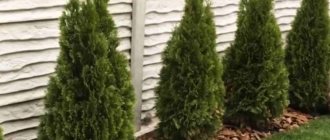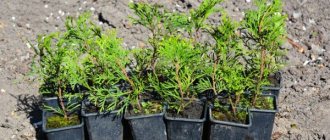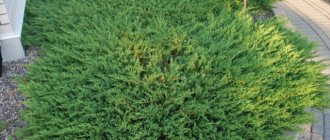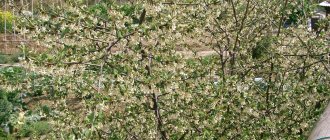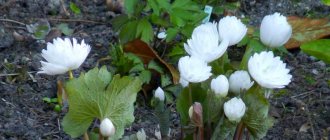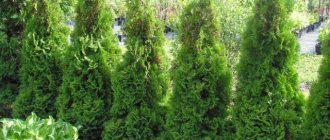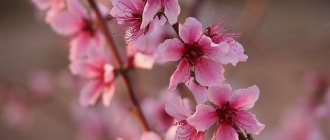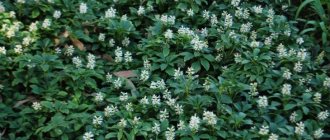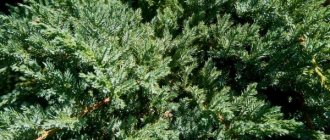Description of Rhododendron Katevbinsky
Evergreen Katevbinsky rhododendron (rhododendron catawbiense) is a shrub used as a garden plant and the basis for breeding work to create winter-hardy varieties. Its genes are present in many frost-resistant species.
The height of the bush is up to 4 m, the diameter is slightly larger. At the age of 10 years it reaches 1.5 m in height. At the same time, the annual growth is 10 cm.
Young shoots of Katevbinsky rhododendron have felt pubescence and later become bare.
The leaves of the plant are elliptical, smooth, with blunt ends, up to 15 cm long and 5 cm wide, with 16 pairs of veins. Their color is dark green, with shine. Petioles - 3 cm.
Twenty large bell-shaped flowers of lilac, purple, violet-red shades are connected in inflorescences. Their pedicels are 3 cm long and covered with hairs. The corolla has a diameter of 6 cm and has rounded lobes. The flower has 10 stamens, the style is bare. Flowering lasts about a month. Katevbinsky rhododendron has no aroma.
Flowering of Katevbinsky rhododendron
Flowering lasts only 1 month. The inflorescence includes 15-20 flowers in the form of bells of different shades - white, purple, red, yellow, etc. Until the flowering period has arrived, the shrub attracts attention with its large and smooth leaves.
If the rhododendron does not bloom, it means it lacks nutrients or the growing location is not suitable.
Winter hardiness of Katevbinsky rhododendron
Frost resistance allows you to endure winter stress in the form of precipitation, wind, frost, icing, and short-term thaw. Maximum frost resistance refers to the extremely low values that plants can successfully survive.
Katevbinsky rhododendron grown in the Moscow region has the properties and advantages of winter-hardy varieties:
- very high frost resistance;
- compactness of the bush;
- the branches are rigid and not susceptible to injury under the weight of snow;
- hardening, which allows flower buds to survive the winter.
Katevbinsky rhododendron came to Europe from North America; its qualities are used to develop new varieties.
Important! The most important property of Katevbinsky rhododendron is frost resistance, the ability to grow and bloom in the most severe climatic conditions.
Homeland of the plant
Rhododendron Katevbinsky appeared in Europe in 1809, it was brought from North America. It was one of the first introduced species, which spread very quickly due to its unpretentiousness and winter hardiness.
Full size shrub
For your information! At the moment, the species is actively used not only in landscape design, but also in breeding programs to obtain new evergreen frost-resistant varieties.
In nature, rhododendron can be found in North America, in particular in its eastern part, in the Allegheny Mountains. Shrubs form entire fields in open areas or grow in groups among forests. Emerald green specimens are also common in Japan.
The flower came to Latvia in the mid-19th century; in the climatic conditions of the Baltic states, rhododendron blooms and bears fruit profusely. Thanks to the shrub’s ability to withstand frosts down to −30°C, it can be found in the Far East and Kamchatka.
Varieties of rhododendron Katevbinsky
In order to choose a specific variety, you can get acquainted with the Katevbinsky rhododendron and its varieties from the photo or visit a flower exhibition. First, you need to decide on the requirements for azaleas: the size of the future plant, its characteristics.
You can choose a variety to suit every taste.
- If you need a deciduous shrub, then you can opt for Katevbinsky rhododendron (azaleas) Feuerwerk. It is decorative not only with scarlet flowers, but also with orange leaves in the fall. The plant will decorate the garden in September no less than in summer;
- The large lilac inflorescences will delight gardeners with the Katevbinsky rhododendron Boursault - an evergreen shrub with impressive dimensions: up to 2 m in height and 2.5 m in diameter;
The most popular and beautiful varieties are:
- Roseum Elegance;
- Album;
- Burso;
- Cunninghams White;
- Grandiflorum;
- Nova Zembla.
Rhododendron Katevbinsky Roseum Elegance
The hybrid was obtained in England in the middle of the 19th century. This is an evergreen shrub, reaching a height of 3 m. Every year its shoots increase by 15 cm. The crown of the bushes is thick and dense. The leaves are leathery, shiny, dark green.
Purple inflorescences with copper speckles of 15 buds bloom in June. Flowering continues for two weeks, which, with proper care, can repeat in the fall.
As you can see in the photo, Katevbinsky rhododendron Roseum Elegans looks great in single plantings, on lawns, under the canopy of coniferous and deciduous plants. Group arrangement is no less impressive. Even a separate bush in any corner of the garden looks stylish and elegant.
Rhododendron Katevbinsky Album
The description of Rhododendron Katevbinsky Album indicates that it is an evergreen, spectacular shrub that has a spherical crown shape, slightly raised and dense. In adulthood, the plant reaches a height of 3 m. Its annual growth is 15 cm. The leaves of the plant are leathery, dark green, and long.
Album flowers are extremely beautiful. Their buds are pink, and after blooming they are white with a golden mark. Flowering occurs early, already in mid-May.
The frost resistance of the crop is good. Foliage needs protection from sunburn in winter. The plant loves light, but does not tolerate shadow well. It is resistant to pests and diseases.
Rhododendron Katevbinsky Album is used for landscaping areas, parks, and gardens in combination with other ornamental trees and shrubs. The plant looks especially advantageous against the background of coniferous plants.
Rhododendron Katevbinsky Burso
This is a fairly old variety, born in 1849. It is considered one of the hardiest.
The hybrid rhododendron Katevbinsky Burso has dark green shiny elliptical leaves, the length of which is 14 cm, width - 5 cm. The abundant flowering of the species begins in June and lasts three weeks. Large lilac flowers are collected in 20 inflorescences, later turning pink and even white. The plant's shrub is tall, up to 4 m, produces large annual growth, loves acidic, well-drained soil, and does not tolerate waterlogging.
In open spaces, shrubs require shelter from the winds and spring sun. Wilted inflorescences should be removed to allow flower buds to form next year.
Rhododendron Katevbinsky Burso is very decorative during flowering and after it, which is used by flower growers when decorating lawns, lawns, estates, and gardens.
Rhododendron Katevbinskiy Cunninghams White
In Scotland, in the middle of the 19th century, a very elegant variety was bred - Cunninghams White. The Katevbinsky rhododendron bush is small, its height is 2 m, the crown diameter is 1.5 m. The leaves of the bush are leathery, dark green, light at the bottom. The inflorescences are large, white, with brownish specks on the petals. Flowering lasts about 3 weeks. It is recommended to choose a place for the plant that is quiet, protected from drafts, and shaded. Rhododendron Katevbinsky requires increased moisture in dry years. He loves rich soils, but is also tolerant of poor, alkaline soils. The plant has high winter hardiness provided the bush is covered and the soil is mulched.
Experts recommend the use of Cunninghams White for hedges that are not trimmed. It is possible to plant the crop singly and in groups, in combination and in compositions with other ornamental plants in rose gardens, on terraces, and lawns.
Rhododendron katevbinskiy Grandiflorum
This is one of the oldest varieties, obtained from selected seedlings of wild Katevbinsky rhododendron. The evergreen Grandiflorum has a spreading, ball-shaped crown and elliptical, leathery, bright green leaves. The shrub is frost-resistant and grows quickly. Its flowering begins in June. The purple inflorescences with a greenish-yellow spot are large, odorless, and contain up to 15 flowers.
Like all heathers, Katevbinsky rhododendron prefers well-drained soil and is tolerant of dimly lit areas.
Important! This variety is recommended for cultivation in the northwestern regions of the country.
Wintering rhododendron
- autumn care - preparation for winter
At the end of summer, it will be useful to add colloidal sulfur to the soil: it will slow down the growth of fungi and acidify the soil. It is also recommended to treat rhododendron with a fungicide against fungi. Continue watering until the ground freezes completely.
- how to cover a rhododendron
In winter, it is necessary to protect evergreen shrubs from the sun and wind. For this, shelters made of sticks, boards or boxes are sufficient. The whole thing needs to be wrapped in non-woven material on top. If the rhododendron grows in the shade, you can take a chance and leave it without shelter for the winter.
Don’t forget about the mulching layer of pine needles and peat - it will reduce the depth of freezing of the ground
Planting and caring for Katevbinsky rhododendron
Katevba rhododendron is one of the most winter-hardy crops. Its kidneys can withstand temperatures down to –25 oC. It is not afraid of thaws and frozen soil in winters with little snow. It is more difficult for a plant to withstand the scorching rays of the sun in winter and spring. The optimal temperature range is from -15 to +25 oC. In the middle zone, it is worth mulching the soil near the Katevbinsky rhododendron and covering it with agrofibre to protect the foliage from burns.
Soil requirements are not high. The main thing is that they are not calcareous, very sandy or exclusively clayey. Plants will die if their roots are constantly in water. The best composition for the soil mixture is forest litter, peat and sand.
Planting is carried out in spring in cloudy weather. The soil should be moist. The earth ball is soaked in water for several minutes. The planting hole is made wide, but not deep.
Selection and preparation of a landing site
The choice of location for Katevba rhododendron depends on whether it is deciduous or evergreen. The former require a lot of light, they can grow in the shade, but will bloom poorly. The latter love shading. All Katevba varieties do not tolerate drafts or drying winds. An area near a fence or tall trees is quite suitable for planting them. You must not allow snow to fall on the bushes from the roof of the house. Since Katevba rhododendron has superficial roots, its neighbors should not be birch, linden, willow, maple - plants with the same structure of the root system. The roots of oak, larch, pine, apple and pear trees grow deep. They can peacefully coexist without interfering with each other.
Seedling preparation
Katevbinsky rhododendrons tolerate transplantation and change of location better at the age of 3 years. It is worth purchasing them from a trusted nursery, where there is a guarantee of purchasing a healthy, varietal seedling. It needs to be inspected. The leaves and stems of the plant must be healthy, without spots, swelling, or damage. It’s good when the bush begins to branch near the neck.
Advice! The best purchase option is a seedling in a container.
Before planting the plant, it is recommended to thoroughly wet the earthen ball and carefully remove it from the container. Sometimes a felt layer of dead roots is found on the coma. It is carefully removed, the seedling is lowered into water and kept in it until the bubbles stop coming out. When the roots and earthen ball are saturated with moisture, you can begin planting.
Landing rules
To plant Katevbinsky rhododendron, several rules must be followed:
- since the roots of the plant are superficial and spread horizontally, therefore the width of the planting hole should be twice its depth (30 cm and 60 cm);
- the pit is made much larger than the earthen ball of the seedling;
- a drainage layer of broken brick, pebbles or crushed stone is required;
- the soil mixture is poured onto the drainage in a layer of 10 cm and watered abundantly;
- install the seedling vertically, its root collar should be 5 cm above the ground;
- after the soil settles and the neck drops to the ground level, the substrate should be added and watered generously;
- then pour a layer of mulch from peat, pine needles or oak leaves;
- For several days, the Katevbinsky rhododendron should be shaded using fabric, mesh, or a paper cap.
Watering and fertilizing
Watering of Katevbinsky rhododendron is carried out moderately, with rain or settled warm water. Moisture must penetrate to a depth of at least 30 cm. Faded and matte foliage signals the need for watering. Periodic morning spraying of plants should be carried out to maintain the required air humidity (about 65%). The watering norm for adult Katevba rhododendrons is about 10 liters of water for 1 bush three times a week. For young plants, the rate is reduced by half.
Additional watering is necessary in preparation for winter. At this time, the plant is moistened abundantly and the layer of mulch around the bush is increased.
Feeding should be done several times a season. When planting, microelements are added to the soil. Nitrogen is added in early spring and before flowering ends. In the fall, fertilizing is carried out with phosphorus and potassium fertilizers.
Trimming
Only if necessary, the Katevbinsky rhododendron bush is pruned. The procedure is carried out no more than once every 3 years. The reason may be the need to renew the bush or freezing of the shoots.
Most often, pruning for the purpose of shaping is not required, since the Katevbinsky rhododendron has a regular and beautiful natural shape.
If shortening or cutting branches is necessary, you should know a few nuances:
- the procedure is carried out until the kidneys swell;
- the cut is made directly above the dormant bud and treated with garden varnish;
- some time after pruning, the plant will begin active growing season, during which Katevba rhododendron is regularly watered and fed.
In order to rejuvenate the bush or cut out branches damaged after wintering, they are shortened at a height of 30 cm from the soil level. To facilitate the restoration of the bush, pruning is carried out for 2 years - half annually.
In order for the deciduous Katevba rhododendron to be thick and voluminous, it is necessary to pinch out young shoots in June, remove faded buds after flowering, and cut out all weakened branches in September.
Preparing for winter
To prepare for the winter period, fertilizing with nitrogen is stopped in August and they switch to potassium fertilizers, which allow young shoots to ripen.
Katevba rhododendrons should be treated with fungicides to prevent fungal diseases.
Attention! Before final freezing, it is necessary to water the plants abundantly.
Winter shelter depends on whether the rhododendron is evergreen or deciduous.
For deciduous species, it will be enough to additionally mulch the soil with pine needles, leaves, and peat. A young plant (up to 3 years old) should be fully covered like evergreen varieties:
- Create a frame from boxes, planks, sticks.
- Cover the root system with mulch from pine needles and peat.
- Cover with non-woven material in several layers over the frame.
- Leave some air space between the shelter and the branches.
- Complete cover should be carried out after the onset of frost, in November-December.
- The top of the plants is covered with film after the final onset of winter frosts, leaving room for ventilation.
Important! When sheltering, it is worth taking into account the climatic features of the region.
Landing rules
Despite the unpretentiousness of rhododendron Grandiflorum and the ease of caring for it, some conditions must be met. An incorrectly selected soil composition can lead to a lack of flowering or the death of the entire shrub. If you choose the right planting site, then nothing else is required except watering.
Boarding time
The plant should be planted in a permanent place before flowering - in early spring after frost or in early autumn. Rhododendrons have a shallow root system, so the top layer of soil should already be warmed up, and precipitation could not harm the shrub.
Flower shoots are sensitive to drought, so the mid-season is best for replanting.
Place and soil for planting rhododendron katevbinskogo Grandiflorum
Rhododendron Grandiflora tolerates shade well, but will still feel better on the south side, but without direct sunlight. Places with diffused light, such as under trees or a canopy, are also suitable.
Important! When choosing a place to plant, you need to check in advance whether there are any drafts there. Constant winds can dry out the shoots of the plant.
Soil requirements:
- slightly acidic or sour;
- wet;
- loose;
- rich in organic matter.
Before planting, the rhododendron can be placed in water so that it is saturated with moisture. Increased soil and air humidity is the key to good flowering. Therefore, it is recommended to install automatic waterers in the garden plot or manually spray the shoots daily.
Note! It is better to plant shrubs next to those trees that have similar soil requirements. This way, neighbors will not take nutrients from each other. Fruit trees can lead to depletion of shrubs, as they draw all the water from the soil.
If there is frequent precipitation in the region, this can lead to stagnation of moisture, which leads to rotting of the roots. To protect the ornamental shrub, it is better to immediately plant it on a hill. In temperate climates, a drainage layer is made in the planting hole.
To acidify the soil, you can mix several types of soil: garden soil, peat soil, rotted pine soil, clay soil, and add sand. Sand and clay should be no more than 20% to maintain breathability.
How Rhododendron Grandiflorum blooms
Seedling preparation
It is best to use a seedling that is three years old, but the possibility of transplanting younger or older specimens is not excluded.
Before planting, the shrub is dipped in a container of water until no more air bubbles are released. Long roots can be trimmed, the rest can be simply straightened.
Important! When planting, the root collar of the Katevbinsky Grandiflorum rhododendron should remain above the ground.
Fertilizer application
Rhododendron katevbinsky Grandiflora absorbs many nutrients. In poor soils, its leaves will become pale and thin, and very few flowers will appear during the flowering period.
To avoid the above, plants are fed from the beginning of spring until the end of flowering. This is necessary for both young and adult shrubs. The last feeding is carried out when the bush has completely faded and new shoots begin to form.
Suitable for Rhododendron catawbiens Grandiflorum:
- organic fertilizers, in particular, semi-rotted cow manure, diluted in water in a ratio of 1:15;
- horn flour;
- calcium and magnesium sulfate;
- potassium nitrate.
At the beginning of spring, nitrogen preparations are introduced into the soil, in June compositions with potassium and phosphorus, and in July nitrogen is excluded.
Note! To preserve moisture and nutrients in the soil, the tree trunk circle of the shrub is mulched with pine needles.
Reproduction
Katevbinsky rhododendron can be propagated in several ways:
- cuttings;
- layering;
- seeds.
For the first method, cuttings 8 cm long are cut from adult plants, placed in a solution of a growth stimulator for 12 hours and planted in a mixture of sand and peat, covered with polyethylene. Ventilation and watering must be carried out periodically. After 4 months, the cuttings are rooted and then transplanted into a substrate consisting of peat and pine needles.
Reproduction of Katevba rhododendrons by layering consists of digging in a young shoot, without separating it from the mother plant. After rooting, the seedling is placed in a permanent place.
The third method involves sowing seeds into peat to a depth of 1 cm. After several leaves appear, the seedlings are planted in separate containers. They are assigned to a permanent position only in the second year.
Features of reproduction
Reproduction of Katevbinsky rhododendron can be carried out vegetatively (layering, cuttings) or through planting seeds.
Rhododendron Helliki: description
Cuttings are carried out from the second half of June. To do this, young healthy shoots 8-10 cm long are harvested, removing the lower leaves from them and leaving a couple of upper ones. To ensure successful rooting, the cuttings are kept in a growth stimulator for several hours. Next, they are buried in soil of a suitable composition and greenhouse conditions are created, covered with film or a glass jar. The evergreen rhododendron grandiflorum will give roots in 3-4.5 months.
Note! The seedling is grown for 2 years: in winter in bright, cool rooms, and in the summer in the garden.
Rhododendron cuttings
When propagating by layering, a small piece of bark is removed from the selected branch, pressing the shoot to the ground in the bare area using a special clamp. If the conditions of care are met, after a year a fairly large young plant will sprout at the site of the cutting, which can be separated from the mother bush and planted in another area.
To grow rhododendron from seeds, the seed is planted superficially in January. Germination will occur only when maintaining a constant temperature of 20 °C. The sprout can be transferred to open ground no earlier than the second year of life.
Diseases and pests
Despite the resistance of Katevbinsky rhododendron to diseases, under unfavorable climatic conditions and violations of plant care rules, pathologies can develop:
- tracheomycosis wilt - the roots become brown and rot;
- late blight rot - provokes the covering of stems and roots with crimson spots, their rotting, after which the plant withers;
- bacterial cancer - when growths form on the roots, the plant dies;
- bud rot - the buds of the Katevbinsky rhododendron turn brown, and later wither and dry out;
- wax disease - deformation and thickening of leaves.
Among the pests of rhododendron Katevbinsky, the most common are:
- sulcata weevil;
- spider mite;
- tobacco thrips;
- rhododendron bug;
- whitefly;
- snails and slugs.
Characteristics and description
Rhododendron forms a lush spherical bush. The height of the plant reaches 4 meters. Glossy leaves in the shape of an ellipse are dark green. The root system is buried 40 centimeters.
It blooms with pink bells with a diameter of 6 centimeters. They are collected in brushes of 20 colors. The flowering bush creates the effect of a pink cloud, for which it is called a rose tree. The plant is long-lived, growing up to 100 years. Rhododendron Katevbinsky blooms in May, flowering continues for a month. When flowering ends, fruits form. These are seed pods. The seeds reach maturity in October.
Care
Plant care includes the following work:
- Watering.
- Fertilizer application.
- Mulching and loosening.
- Removing weeds.
Following the rules when performing these works will help to grow a healthy and beautiful plant.
Drainage
If the site has heavy clay soil, it is necessary to make drainage before planting rhododendron. The drainage layer is laid at a depth of 10-15 centimeters. Gravel, coarse sand, and crushed stone are suitable for this.
Mulching
Mulching is done to protect the roots from overheating, retain moisture in the soil, and suppress weeds. The best mulch for rhododendron is fallen pine needles, sawdust from coniferous trees, and dry peat.
Watering
Heather crops do not like the soil to dry out due to the shallow location of the roots. Water the plants 2 times a week in hot weather. Young bushes are sprayed. Humidity should not be excessive; water only when the top layer of soil dries out.
Feeding
In spring, rhododendron needs nitrogen. Make a solution from 1 tablespoon of ammonium nitrate and 10 liters of water. During flowering, the bushes are fed with acidic fertilizers for azaleas. In August, potassium sulfate is added - 1 tablespoon per 10 water. To acidify the soil around the bushes, colloidal sulfur is scattered (40-80 grams, depending on the size of the bush).
Bloom
During flowering, rhododendron requires special attention. It is fed and watered abundantly. It is important to remove faded inflorescences so that they do not interfere with the development of new ones and do not make the bush untidy.
Trimming
Pruning is done in early May; this plant is given a rounded shape and neat appearance. Sometimes this procedure leads to delayed growth and flowering of the bush. Pruning is replaced by pinching shoots.
Wintering
The roots of the plant are mulched with dry peat, sawdust or pine needles. For rhododendron, temperature changes in winter and snow sticking to branches are dangerous. A support is installed around the bush and wrapped in lutrasil or other material that allows air to pass through. You can bend the bush to the ground and cover it in a similar way.
Rhododendron: Salute the King!
| variety Spriditis |
Continuing the conversation about evergreen ground plants, I would like not to ignore the beautiful flowering shrubs, including His Majesty Rhododendron, the largest genus of the heather family. And such respect is completely justified. The main natural habitats are the vast mountainous expanses of East and Southeast Asia and the temperate zones of North America. The Caucasian mountain ranges are also the ancestors of a number of rhododendron species. Recently, more and more printed publications of varying degrees of complexity have begun to appear on store shelves. The supply of plants themselves from foreign nurseries is also gaining momentum. But until now, rhododendrons are rarely seen in our Russian gardens. This is too complex a crop, too sissy, to grow in a private garden - this is a well-established misconception. Let's try to dispel it.
There are three main forms of rhododendrons: deciduous, evergreen and intermediate. The first ones are the easiest to grow, since wintering is not stressful for them (the leaves have been shed). But at the same time, they are no worse in terms of decorative qualities during flowering than representatives of the other two groups. Among other things, deciduous forms, one of the parents of which was the yellow Rhododendron (Rhododendron luteum), also “bloom” in the fall. Their leaves are painted in all sorts of shades of red-orange-purple tones, adding a bright color accent to the late autumn garden. And they fall only in October-November.
An intermediate option is semi-evergreen forms. They are usually small in size and go completely under the snow cover. The height of the bushes does not exceed 50-60 cm. And the plant sheds most of its leathery, blueberry-like leaves in winter. By spring, only at the tips of the branches there are several pairs of leaves surrounding the flower buds. But when they bloom in May, the bushes look like colored buns, the flowers are so densely arranged. A touching sight! And yet, within the framework of this presentation, I would like to pay the main attention to evergreen forms.
Rhododendron is a word of Greek origin, where rhodo means rose and dendron means tree. In the form of trees sometimes up to 30 m, rhododendron is found mainly in its homeland, in the Himalayas at an altitude of up to 2.5-3 thousand m above sea level (a.s.l.). At an altitude of 4 thousand m above sea level. dwarf forms grow 20-30 cm high with small evergreen leaves. They form continuous flower carpets. But for the most part these are bushes or small trees, unsurpassed in beauty during flowering. In a word, if the rose is the queen of flowers, then the rhododendron is the king. And as strange as it may sound, it is better adapted to cold climates than roses. Rhododendrons are mountain plants and mostly spartans, not sissies.
The second homeland for rhododendrons was Scotland - the first place in the Old World, where in the 17th century rhododendron seeds were brought and the first seedlings and hybrids were grown. Great Britain currently holds the main collections of rhododendrons: this is the London Royal Botanic Garden in the Kew area (where there are also small trees). An equally impressive sight of rhododendrons in bloom in May in the garden of the Royal Horticultural Society in Wisley, near London. This state of affairs is not accidental. It is in England that the climate and topography (Scotland) most closely correspond to natural conditions: mountainous terrain and huge masses of moist air are the main conditions for the growth of this crop at moderate temperatures in both summer and winter. Later, breeding work with rhododendrons was carried out in Belgium, Holland (mainly indoor rhododendrons - azaleas) and Germany (including in the Hachman nursery, which has been on the market for 75 years). The American continent also did not lag behind and produced many ornamental varieties. There are quite good collections of rhododendrons in the Czech Republic (Pruhonice), and in the post-Soviet space - in Latvia (Botanical Garden of the University of Riga). And this is also understandable (climate!).
Unfortunately, in Russia there is no public place to admire these luxurious plants, so all hope lies in private gardens. There is a King among Kings - specific
| Rhododendron katevba |
Rhododendron catawbience and its hybrids, absolutely frost-resistant in the middle zone (-30°C) and undemanding in care. The main suppliers of planting material at the moment are Polish, German and Finnish nurseries. Rhododendrons, especially in the ground, are not fast-growing plants. Therefore, the prices are appropriate. But can we be stopped?!
If you are ready to spend a little effort and time caring for these beauties, then they will certainly give you lush blooms.
And efforts must be made in strictly defined directions. First of all, this is the choice of landing site. As a rule, evergreen forms require diffuse shade. Pine groves are an ideal place. In addition to pine, trees with a deep root system - oaks, larches - will coexist friendly with rhododendrons; garden trees include hawthorns, serviceberry, apple trees, pears, and cherries. But maples, willows, alder, linden, spruce, poplar and elm are undesirable neighbors. Rhododendrons planted under birch trees are perceived very harmoniously, but since the birch tree is a powerful pump (on a hot day it extracts and evaporates up to 200 liters of water from the soil), and its roots extend tens of meters from the trunk, it is undoubtedly clear that the strongest will win. Don't, don't experiment! All the same, sooner or later the “baby” will die, but even if he lives, it will be in pain.
So, the place has been chosen. All that remains is to provide “mountainous terrain.” Well, mountains are not mountains, but for the King you should build at least a podium 15-20 cm high above the level of the path, and for high-mountain dwarfs you should also stock up on pebbles. And in general, as Igor Gorin colorfully put it: “Rhododendrons without stones are like a royal dynasty without a princely retinue.” A very harmonious combination. Small pebbles (granite or pebbles in origin, but not limestone) are mixed into the soil, and large ones (up to boulders) are located next to the elevation or form one of its surfaces. All this is constructed in order to provide the pet with completely air-saturated soil. When the root ball gets soaked, rhododendrons die; they are not swamp plants, they are mountain plants (except for Rhododendron canadense).
Of course, they can also grow on a horizontal surface. In all cases, it is necessary to provide them with natural growth conditions: air- and moisture-retentive soil with an acidic reaction environment. On poor soils, flowering, if any, will be scanty. There is no escape; the law of conservation applies to varietal material: what you feed is what you get. The acidic reaction of the soil is ensured by the addition of sphagnum moss and high peat (not neutralized, pH 3.0). Peat is one of the main components of the soil for rhododendrons.
And, of course, watering. It is especially preferable in the form of sprinkling (for air humidification). The root system of rhododendrons is small and shallow (up to 30 cm), consisting of a lump of earth and thin roots. And here, be careful. Before planting a purchased specimen, be sure to wet the root ball for at least 24 hours by removing it from the container. You can soak it in water or a stimulant solution, but not for 10-20 minutes, as recommended on the label. The air will come out, but the peat (the substrate in which the rhododendron grew) will not have time to become saturated with moisture during this time. Death is guaranteed (verified!), slow (up to two years), painful, even if you water it all the time. If such an “experiment” has already been carried out, it is better to repeat the planting again, this time with impregnation of the coma. Due to the compact root system, such action is possible either in early spring or in July-August.
And one more significant moment in the life of evergreen rhododendrons is wintering. The problems of wintering evergreen plants in Russian conditions have already been described. For evergreen, non-deciduous forms of rhododendrons, which have large leaf plates, protection from drying winds and scorching sun in winter and early spring is very important. For this purpose, moisture-recharging irrigations are required in the fall throughout September and October (down to a temperature of 0°C). In addition, shading with any light material on the frame is necessary, preferably in the form of a hut, so that the snow does not break the plants. Of course, a more aesthetic design is possible - a hut made of spruce branches, but in most cases this is a more barbaric option.
We can talk endlessly about the beauty and needs of rhododendrons. But I want to believe that even the little described will increase the number of rhododendron fans.
Photo by Richard Kondratovics

